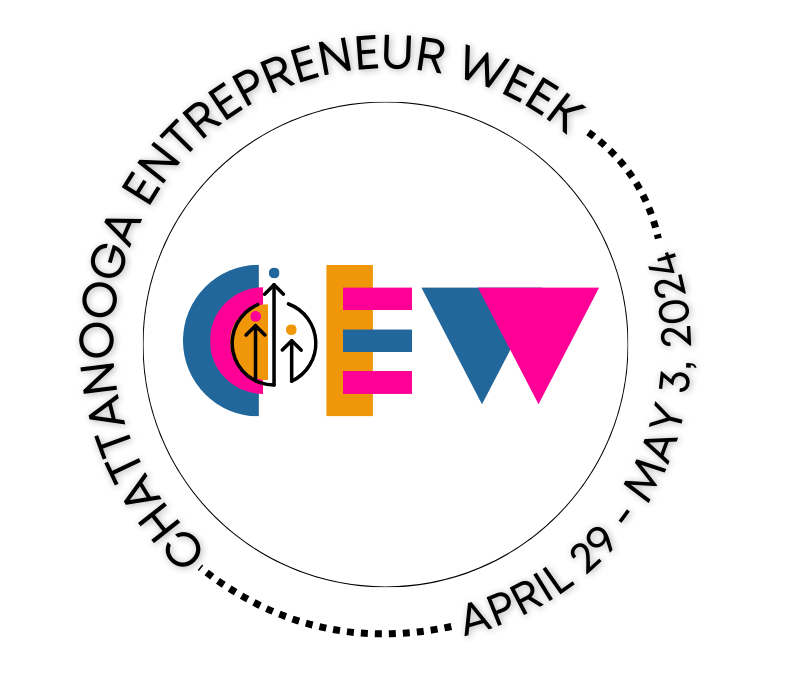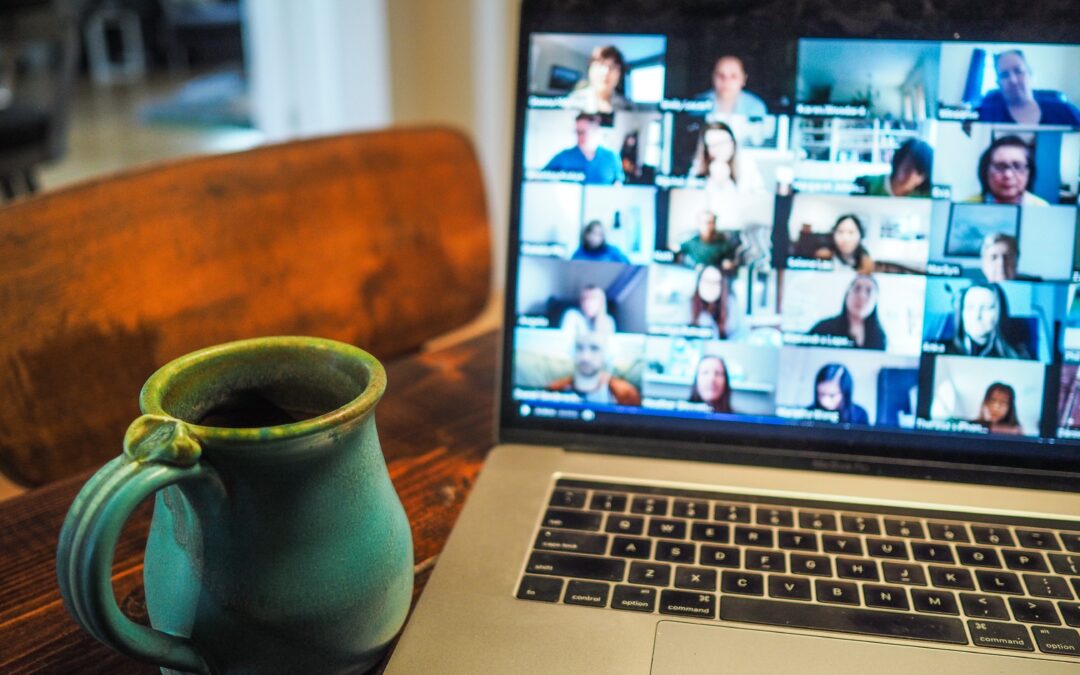
by Cortina Jenelle | Apr 1, 2024 | blog, business, entrepreneurs, imagination
It’s always a win-win when I get to do branding and web design work for a cause that I’m incredibly passionate about. I’m not privvy to have favorite clients butttt, I’m really honored to have been part of the work with the inaugural Chattanooga Entrepreneur Week, produced by Chattanooga Business Resource Collective and happening the week of April 29th to May 3rd, with main events @ Finley Stadium & First Horizon Pavilion.
I fell in love with entrepreneurship at the ripe age of 12 years old.
Working inside of my grandmother’s catering business for years and witnessing her grit, service, abundance, hard work and purpose made me want that for myself, even though I didn’t know it at the time. This woman was able to travel and share her love of cooking with some of the dankest fried catfish plates at festivals, events and gatherings all along the East Coast and often reminded me how risky it was being a Black woman in business from the rural South. At one point, I worked in corporate and in nonprofits and hospitality and sales and customer service and healthcare and social work and tech/IT. Trying…HOPING…that I could get a job, and stay in that job long-term, retire from said job and have a simple, quiet life.
I tried to keep my distance from entrepreneurship. Truly, I did.
But God had other plans. And I’m glad He did.
Entrepreneurship represents so many things for, and to, me now. Maybe the three most important reasons I love entrepreneurship and see it as upward mobility in ANY community are:
✅ It’s one of the best ways to solve our own problems.
✅ It’s one of the best ways to build generational wealth.
✅ It’s the best way to serve and support our neighbors and positively incentivize experts in their craft to keep developing their craft.
All things considered, I’m excited for the upcoming lineup of events at the inaugural Chattanooga Entrepreneur Week, presented by Tennessee Valley Federal Credit Union (TVFCU). The main conference and most events are FREE! Schedule of events and more details are available at www.chabusiness.org/cew.
Branding, graphic design and web design by yours truly 🎯 💫 🚀

by Cortina Jenelle | Aug 8, 2023 | blog, business, creative coach, entrepreneur coach, entrepreneurs, facilitation
The digital age has redefined how we work, learn, and connect. In response to recent global challenges, the embrace of remote work, virtual meetings, and online learning has only grown stronger, shaping new paradigms for the modern professional – with no slowing down in sight. As a freelancer over everything and an introverted processor, I have been working remotely for nearly 10 years. Tools like Asana, Slack, Google Suite, Honeybook and LinkedIN were my go to’s early on in 2013 and I cannot begin to tell you how excited I am to witness the roster of tools growing With these changes come distinct trends that are molding our digital experiences.
Hybrid work models are becoming the new norm, with companies permitting employees to enjoy a blend of office and remote work. Online learning platforms are integrating game mechanics to keep engagement high and enhance retention, a phenomenon known as gamified learning. Meanwhile, virtual and augmented reality are no longer just buzzwords or some “out there” concept, they are beginning to create immersive meeting and learning experiences that captivate and inspire.
Accessible Options for Remote Work + Virtual Meetings:
- Airtable: A blend of spreadsheet and database, it offers dynamic ways to organize content, track tasks, and manage projects.
- Google Meet: Integrated with other Google services for reliable video conferencing.
- Microsoft Teams: Your one-stop hub for collaboration, including chat, video meetings, and file storage.
- Slack: Messaging made simple and efficient for teams with channels and integrations.
- Trello: Visualize your tasks and projects with its unique board and card system.
- Moodle: An open-source Learning Management System tailored for the educators of today.
- Kahoot!: Learning meets fun with this game-based platform, perfect for quizzes and interactive sessions.
- Miro: Brainstorm and collaborate with this digital whiteboard tool.
- Notion: An all-encompassing workspace platform that goes beyond just notes and tasks.
- Discord: From gamers to study groups, a platform to build and nurture communities.
The modern era, marked by its rapid digital evolution, emphasizes the significance of staying connected, informed and adaptable. That in mind, it’s important to make sure that any platform you use, especially if a requirement for your team or workplace, is inclusive and accessible for everyone. All the platforms I name above are FREE to use and offer a lot of functionality even with no payment requirement. The more you upgrade, the more robust your features are so that’s fun too!
Harnessing the power of digital tools not only ensures smooth communication but also fosters growth, innovation, and unity in both professional and personal spheres. Whether you’re a digital novice or a seasoned tech enthusiast, these platforms and trends are pivotal in crafting a connected and efficient future. If nothing else, I’m absolutely excited about the time freedom I earn when I can train these digital tools to keep me organized + connected.
Happy relating!
Photo by Chris Montgomery on Unsplash

by Cortina Jenelle | Jun 21, 2023 | blog, business, entrepreneurs, imagination
The modern workplace is undergoing a significant transformation.
With millennials now forming the majority of the global workforce, the traditional parameters of workspaces are being redefined. In the dynamic world of design and environmentalism, the right setting can be a catalyst for innovation. For the young professional navigating this space, picking the perfect venue for meetings and trainings becomes paramount.A study by Gallup revealed that 43% of millennials envision opportunities to work remotely. With this generational shift, the how and where of professional gatherings are evolving too, emphasizing adaptability, innovation and intentionality.
Millennials, with their distinct values and perspectives, aren’t just looking for a space to convene; they’re seeking venues that resonate with their ethos. This generation is known for championing authenticity, sustainability, and well-being. A venue is more than just a space; it’s an environment that fosters collaboration, ignites creativity, and encapsulates an ethos. For the modern professional, this means a blend of functionality, aesthetics, and sustainable principles. Selecting the right venue becomes an extension of these values, a testament to a commitment to purposeful engagement.
Top 10 Considerations When Selecting a Venue:
- Location Accessibility: Is it easily reachable by public transport or car?
- Tech Infrastructure: High-speed internet, AV facilities, and other tech amenities.
- Sustainability Practices: Does the venue promote eco-friendly measures?
- Space Layout: Open spaces for brainstorming, quiet zones for focused tasks.
- Aesthetic Value: A design that fosters creativity and reflects organizational values.
- Catering and Refreshment Options: Healthy, diverse, and sustainably sourced options.
- Budgetary Fit: Ensuring value for money without compromising on essentials.
- Safety and Security: Adequate measures in place for the safety of attendees.
- Flexibility: Option for rearranging spaces or accommodating special requests.
- Feedback and Reviews: What have previous users said about the venue?
The perfect venue doesn’t just look good; it does good. A venue that incorporates sustainable practices, from energy-saving solutions to waste reduction, resonates with the millennial ethos so this may be important to consider if you’re on the designing side of as a space. Think of the Salesforce Tower in San Francisco, a beacon of eco-friendly architecture, or the Bullitt Center in Seattle, dubbed the “greenest commercial building in the world”, or meeting venues like Proximity Hotel, the USA’s first LEED Platinum Certified hotel. Its management company, Quaintance-Weaver Restaurants & Hotels happened to be the site of my first professional job out of college. These are epitomes of how design and environmentalism can harmoniously coexist. For millennials, these aren’t mere structures but symbols of a progressive future.
As we usher in an era where the line between work and play blurs, where innovation is as much about space as it is about ideas, the onus is on us to make mindful choices. For those seeking to explore potential venues, platforms like Peerspace, Splacer, or even local directories can be invaluable resources.
Remember, whether you’re the person looking for the perfect spot to host your next gathering or the designer of a space for professionals to gather, choosing a venue is no longer just a logistical decision – it’s a statement, a reflection of intent and values. Cheers to forging ahead, building bridges, and laying the foundation for meaningful engagements in spaces that inspire!
Pictured: Common House No. 3, Chattanooga, TN

by Cortina Jenelle | May 24, 2023 | blog, entrepreneurs, facilitation, imagination, liberation
School’s almost out! So, there is no time the present to talk about equity and education.
In the intricate journey of human advancement, the corridors of traditional educational establishments have often echoed uniformity. Yet, there’s a burgeoning movement to champion a more emergent and equitable approach to learning. We can all agree that the year 2020 became a hallmark of rapid transformation. Suddenly, parents were teachers, hall monitors, janitors, lunch ladies, bus drivers and tutors and many school systems scrambled to meet the burgeoning needs of their students. Forced to adapt almost overnight, educational structures began to realize the significance of flexibility and inclusivity. These tumultuous times catalyzed an essential re-evaluation, championing a more emergent and equitable approach to learning. Thus began the new dawn of educational philosophy and a reconstruction period for education as we know it.
Historically, the education system has mirrored societal hierarchies, often entrenching inequalities. But with the civil rights movements and progressive ideologies gaining ground in the 20th century, a push for a more inclusive and adaptive education became evident. Today, this ethos is embraced worldwide, with institutions recognizing the value of diverse thought and fostering environments where every voice matters. At its core, equitable education is about ensuring that every learner’s unique experiences and needs are acknowledged and catered to. Instead of a one-size-fits-all methodology, it celebrates diversity and individual potential. Simplified, it’s the idea that education should be a tailored journey, not a mass-produced product. Students should feel seen, heard, and understood, with the curriculum adapting to them, rather than the other way around.
In this reimagined educational landscape where equity leads, the role of the teacher would have to evolve dramatically. In fact, because of the demands of virtual learning, the role of the teacher already has. Instead of merely imparting information, educators become facilitators and co-learners. They set the stage for exploration and guide the process, but they’re also open to learning from the students. This approach prioritizes mutual respect and encourages learners to take an active role, fostering a community of inquiry and shared discovery. The emergent approach draws inspiration from various philosophies.
The Montessori method, for instance, places children at the center of their own learning journeys, emphasizing hands-on discovery and individualized pacing. The Sudbury model, on the other hand, is based on democratic principles, allowing students significant autonomy in deciding what and how they want to learn. It often involves students participating in administrative decisions, emphasizing respect, freedom, and responsibility. By amalgamating these philosophies, equitable education seeks to create environments where every student is empowered and engaged. And a forest/nature school model facilitates learning in an outdoor setting to teach principles of reciprocity and sustainability.
As we stride into a future characterized by rapid change, it’s imperative to have an education system that champions adaptability, inclusivity, and innovation. Equitable education isn’t just about fairness; it’s about preparing a generation to navigate complexities with empathy and wisdom. So what does this all mean? Only what you want it to. The reimagined philosophy of education doesn’t seem to be a trend, it’s evidence of a necessity that we have been trying to evolve for nearly a century. As we reshape our learning environments, we could also sculpt a brighter, more inclusive future for all.
Photo by Sam Balye on Unsplash

by Cortina Jenelle | Mar 21, 2023 | blog, business, creative coach, entrepreneurs, facilitation, imagination, liberation
In the last decade, the professional landscape has witnessed a profound transformation characterized by the rise of remote work modalities. This shift, indeed a significant one, has necessitated a recalibration of team-building strategies and protocols within organizations globally. We have learned how to push based the work-life balance agenda and arrive into a work-life blend.
As someone who often gets called into team-building spaces, I have observed that the integration of remote work within organizational structures has brought forth an enhanced level of flexibility and individual autonomy. Now more than ever, employees are now afforded the opportunity to design their work schedules in a manner that aligns with their personal productivity patterns, fostering a heightened sense of freedom but also, a responsibility and personal ownership over their tasks.
While it’s exciting to have doors open in a global way, this transition has not been without its set of challenges. The detachment inherent in remote work settings has, to a certain extent, diminished the spontaneous interpersonal connections that were the hallmark of traditional office environments. These casual interactions, often undervalued, were vital in nurturing creativity and fostering a collegial atmosphere. Certainly even some of my favorite co-working spaces design around those “water cooler”, “kitchen counter” conversations that could spontaneously spark creativity and collaboration from the tiniest of seeds. The digital medium, despite its many advantages, can sometimes fail to replicate the warmth and camaraderie that physical offices facilitate naturally. So how do we build robust, dynamic teams in a remote environment?
In response to these challenges, the role of team-building has assumed greater significance. The focus has now pivoted towards the development and implementation of virtual team-building initiatives that aim to bridge the gap exacerbated by physical distance. These endeavors, which include virtual coffee breaks, online recreational activities, and remote team retreats, serve as a catalyst in preserving team cohesion and fostering a vibrant organizational culture, even virtually.
It’s not just the physical environment has changed. The massive re-evaluation of leadership communication strategies is underway right along with going remote. Leaders are now tasked with fostering transparency and maintaining regular engagement with team members to ensure alignment of goals and sustained motivation levels. This paradigm shift calls for a strategic reassessment to facilitate a culture that promotes inclusivity and collaborative efforts, even from afar.
In my opinion, the more balanced, autonomous approach and the benefits it could add to personal well-being and happiness means that remote work may be here to stay. It has introduced a dynamic interplay of autonomy and flexibility, while simultaneously compelling teams to innovate in their bonding and collaborative strategies. Certainly this decade from 2020 onwards will be marked by evolutionary growth and adaptation. As facilitators or leaders of any kind, our role is to guide organizations in navigating these changing dynamics, crafting a work culture that resonates with the evolving needs and expectations of the modern workforce. How are you making that work for you?
Photo by Christina @ wocintechchat.com on Unsplash

by Cortina Jenelle | Nov 4, 2022 | blog, business, creative coach, entrepreneur coach, entrepreneurs, imagination, sovereignty
Business insurance is an essential tool for building wealth and protecting the assets of a company. In today’s unpredictable business environment, it is crucial to have a safety net in place to protect against unexpected events that could otherwise lead to financial loss and bankruptcy. In this article, we will explore how business insurance can help build wealth and provide peace of mind for business owners. Over the last seven years, following the sudden loss of my father, I have become more educated on the necessities and opportunities with insurance. Since he didn’t have any that we know of, there were no assets and no wealth to leave behind. In his honor, I vowed to not make the same mistake and to educate others on financial health and the stable investment into insurance.
I was surprised to find that many people are more consistent with their auto insurance payment than their life insurance premiums. Why? Simply a focus on other priorities and lack of education is my guess. So I decided to focus somewhere in the middle and help other entrepreneurs and small business owners protect their assets (i.e. property, equipment, themselves, etc) so that all of the sacrifices they’re making today are not in vain tomorrow should something unexpected happen.
This is where we begin to see opportunities to build wealth.
First, let’s take a look at the role of business insurance in protecting against risk. Risk is an inevitable part of doing business, but with proper insurance coverage, the financial impact of these risks can be mitigated. For example, a company that experiences a fire or natural disaster could be faced with significant financial losses if they are not insured. Business insurance can cover these losses and provide financial stability during a time of crisis.
Another way in which business insurance can help build wealth is by providing liability protection. Liability insurance can protect a business from lawsuits and other legal actions brought against it. This protection is especially important for companies that deal with customers or clients, as it can help mitigate the financial impact of lawsuits and other legal actions.
In addition to risk protection and liability coverage, business insurance can also provide access to a range of benefits that can help companies grow and thrive. For example, some insurance policies offer coverage for lost income, which can help businesses keep their doors open during difficult times. Business insurance can also provide coverage for employee benefits, such as health insurance and retirement plans, which can attract and retain high-quality employees.
Research supports the importance of business insurance in building wealth. A study by the National Association of Insurance Commissioners found that companies with insurance coverage were less likely to experience financial difficulties than those without insurance (NAIC, 2016). Another study by the Insurance Information Institute found that small businesses that invested in insurance had a higher success rate and were more likely to survive long-term than those without insurance (III, 2018).
In conclusion, business insurance is a valuable tool for building wealth and protecting the assets of a company. It provides protection against risk, liability, and access to a range of benefits that can help companies grow and thrive. By investing in business insurance, business owners can have peace of mind and feel confident in their ability to weather any storm that may come their way.
Photo by Med Badr Chemmaoui on Unsplash
References:
NAIC (National Association of Insurance Commissioners). (2016). The Role of Insurance in the Economy. Retrieved from https://www.naic.org/prod_serv/economic_research_role_of_insurance.htm
III (Insurance Information Institute). (2018). The Benefits of Business Insurance. Retrieved from https://www.iii.org/article/the-benefits-of-business-insurance






